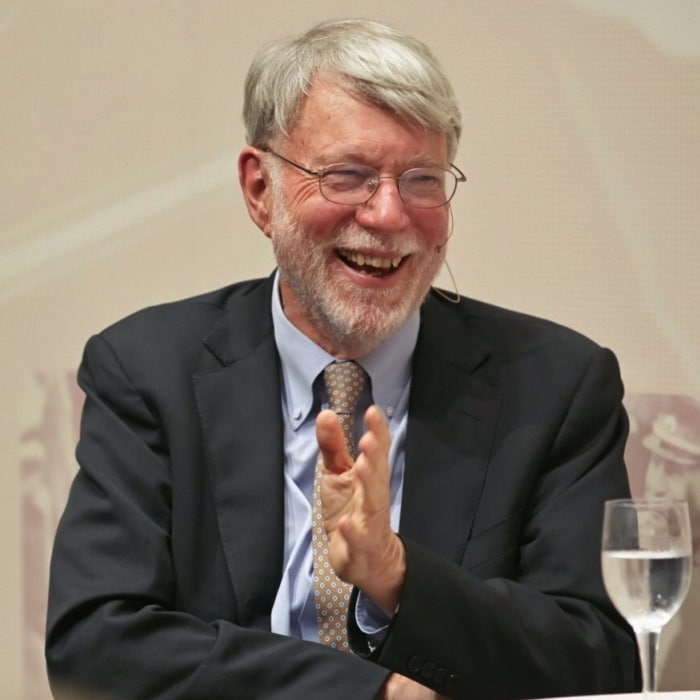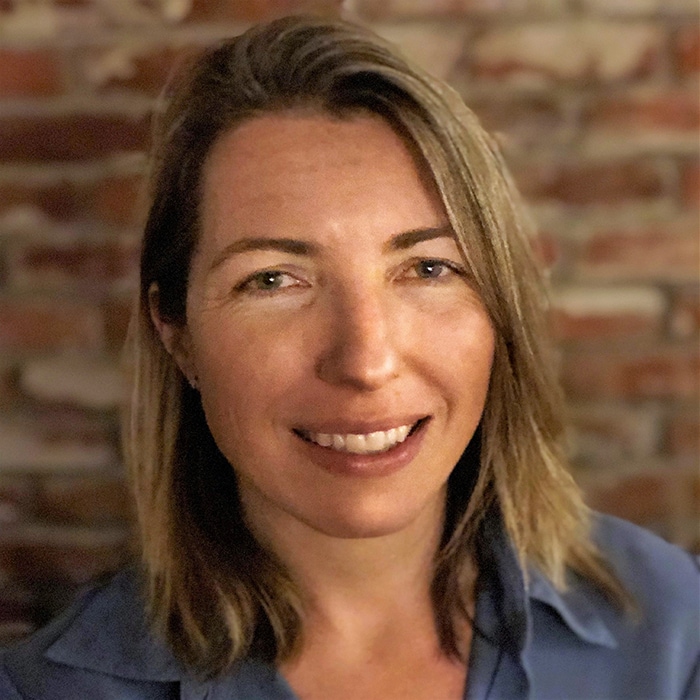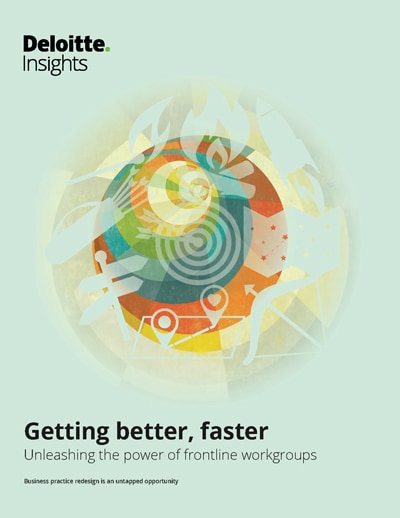Commit to a shared outcome has been saved

Commit to a shared outcome Focus on the outcome that matters most to foster passion and amplify your actions
31 January 2018
 John Hagel III United States
John Hagel III United States John Seely Brown (JSB) United States
John Seely Brown (JSB) United States Andrew de Maar United States
Andrew de Maar United States Maggie Wooll United States
Maggie Wooll United States
How can you get workgroup members to pull in the same direction? It begins with agreeing on and committing to a shared goal, which can help elevate a group’s objectives over individual objectives, creating an expectation and a vehicle for putting aside competing agendas and focusing on the issue at hand.
Introduction: Focus and alignment
A shared outcome is the reason a workgroup exists; it is why group members come together and what they aim to achieve every day—for example, to save lives or to stop cyber-intrusions. For most workgroups, this outcome will support the mission of the larger organization, but it is much more within the group’s ability to control.
When a shared outcome is significant and meaningful, commitment to that outcome can drive a workgroup to take action. It can rally members from different domains and possibly different organizations to work together despite their having competing perspectives, goals, and even performance metrics. A shared outcome can also compel a workgroup to reach outside its membership for help, insight, and resources. All of these—action, generative collaboration, and leverage—are key for workgroups looking to accelerate performance improvement amid rapidly changing conditions and requirements.
When it comes to accelerating performance improvement, the way an outcome is defined is key. No workgroup can definitively achieve a well-defined outcome in the short term. For example, while a group of firefighters might be saving lives every day, there are always more lives to be saved and, conceivably, better, more effective ways to do so. As a result, commitment to a shared outcome typically helps to focus and align workgroup members on what could be done and drives them to constantly take action to get better at achieving that outcome.
Learn More
Explore the practices and case studies
Read an overview of the opportunity
Download the full report or create a custom PDF
Committing to a shared outcome can help elevate a group’s objectives over individual objectives, creating an expectation and a vehicle for putting aside competing agendas1 and focusing on the issue at hand. The significance and meaningfulness of a shared commitment can also help workgroup members to tolerate the potential discomfort of challenging and being challenged by others as a means of getting better and better at achieving the shared outcome. In fact, research indicates that groups with shared outcomes are half as likely to feel that competing priorities hold the group back and a third as likely to complain about constraints due to corporate politics.2
By being larger than any one member and requiring not just every member of the workgroup but also external resources and learning, a significant shared outcome can lead to learning from others. In a world of mounting performance pressure, one of the keys to success could be finding ways to engage and motivate others to help achieve even more impact. Defining a shared outcome can help a workgroup attract the right talent and connect more effectively with others by being clear both about what it is trying to accomplish and where and how others can help.
You know you need this practice when:
- There are competing definitions of success with no consensus
- We have a bunch of solutions but no clarity on what we are solving for
- The workgroup is easily distracted or moving in too many directions at once
The commit to a shared outcome practice: What it is
The optimal shared outcome—this is what we are committed to—can help a workgroup accelerate performance improvement. A well-defined shared outcome should provide clarity, focus, and guidance for making decisions and taking action, orienting workgroups amid uncertainty, and making clear to members where they are heading and what is worth fighting for and what is not.3
Some attributes of a good shared outcome:
- Clear and credible. This is about the basic work of the group; members are the driving influence and doing the bulk of the work.
- Significant. Big enough to inspire and motivate. Group members believe they can achieve it better collectively than individually.
- Broad and open-ended. There is always more that can be done, and doing it typically requires pulling in resources and talent from outside the workgroup.
- Narrow and tangible. Defined to provide focus and guide decisions because it is directly relevant to who they are and the skills and scope they bring to the work. The outcome can give a sense of what success would really look like.
- Meaningful. At its best, a shared outcome has an element that connects to members’ values and identity; achieving that outcome can become personal and meaningful to each of the group members.
. . . and what it isn’t
- The organization’s goals or part of a broader effort. For most workgroups, the shared outcome will support the mission of the larger organization, but it must be within the group’s authority and ability to make a significant impact on the outcome. For example, if the organization has a mission to “improve lives through wellness,” the workgroup’s shared outcome might be to “scale a wellness business.” The exception might be project-oriented organizations such as an urban fire department.
- A quantified goal or target. Workgroups can get locked in on a specific number, causing them to act more narrowly or even game the system, aiming to achieve that number rather than continuously push the boundaries to achieve better and better outcomes.
- An ideal or vision. Lofty goals that aren’t tangible or clear—say, make the world a better place—generally provide too little focus or guidance to prompt action. The group may be inspired but could either become overwhelmed by magnitude of the outcome or paralyzed by the range of potential paths and interpretations of success.
Intersections with the other eight practices
- Frame a powerful question. There is a back-and-forth dynamic between the shared outcome and the question. The shared outcome generally sets guiderails for the direction of the question, while that question animates and adds urgency to the shared outcome. Part of the art is using one to inform the other.
- Seek new contexts. Using a shared outcome as a lens for what matters can help you make sense of new contexts and not get overwhelmed.
- Maximize the potential for friction. A clear, long-term direction around a meaningful shared outcome can help attract diverse members who are passionate about the outcome and can help mobilize others to engage as well. Without it, the workgroup may attract people best suited for near-term events but unprepared to make progress toward longer-term objectives.
- Cultivate friction. Motivated by commitment to a shared outcome, members may be more willing to endure some discomfort in order to participate in practices that increase the type of friction that is generative of new and better approaches.
- Eliminate unproductive friction. By overriding individual agendas, a shared commitment to an outcome can help build the foundation for deeper trust between individuals.4
- Reflect more to learn faster. When group members trust each other’s commitment to an outcome, they may be more willing to reflect and share honestly in order to learn how to have a greater impact on the shared outcome.
- Bias toward action. The shared outcome provides guidance that enables members to move more quickly and confidently into rapid actions that could yield learning, without fear of political reprisals for appearing to make a mistake or having to change direction.
- Prioritize performance trajectory. The shared outcome sets the context for how success would be measured and what metrics would be most relevant for the workgroup.
Putting the practice into play
A shared outcome can be valuable for any type of group. However, for edge workgroups, the way the outcome is articulated and the ways that members choose to deepen commitment to it can influence the size and nature of the group’s impact. Workgroups can create and sustain commitment to the type of shared outcome that accelerates performance improvement by making sure that the most important things are treated as the most important, and by making the shared outcome meaningful to the members. These practices, in themselves, have the potential to drive accelerated performance improvement.
While a shared outcome will remain relatively stable, it should be an ongoing conversation, open to revision as the workgroup and context evolve. Throughout the effort, leaders should entertain suggestions for updating the outcome, periodically surface other interpretations, and then rearticulate the shared outcome to ensure continual team alignment.5 This gives the shared outcome renewed credibility by illustrating that it is connected to its dynamic context—and reassures members of the team that they are a part of the shared outcome.
When you face a tough decision, or when prospects for success look bleak, reminding one another what you are trying to do provides guidance, sustenance, and inspiration.— The Practice of Adaptive Leadership
Make the most important thing the most important thing
The workgroup shapes the nature of their work through the way members define the outcome they are committing to deliver. Even with organizational expectations of what it will deliver, the right outcome on which to align may not be immediately obvious. For example, a disaster response group might define a shared outcome of “saving lives” or “minimizing trauma” or “restoring normal infrastructure function,” each suggesting different priorities and approaches. Without alignment on what the most important thing is for the group, workgroup members may find themselves working at cross purposes or just being slowed down by the need to keep renegotiating priorities. Negotiating and agreeing to a shared outcome will almost certainly raise different and opposing perspectives. This is an opportunity for the group to establish how it will handle friction productively.
Ideally, the workgroup collectively explores how it might define the outcome, up front, to better ensure that all of the members share in and can commit to it. Start by taking the long view, asking: What is the highest impact that we can have? Where can we offer the most value? The idea is to focus first on the future and the opportunities ahead and then work backward. Paradoxically, focusing on a long-term direction could actually help to deal with near-term uncertainty. This can generate excitement, helping groups break free from current constraints and opening up the domain beyond just what group members currently do. For example, a group of firefighters might initially define their shared outcome as “putting out fires” but, upon further discussion, clarify the outcome to be “to save lives” or even “to prevent fires.”
In addition to looking to the future, be bold in considering unexplored horizons that might not yet seem quite possible. Periodically reevaluating the shared outcome can provide an opportunity for the workgroup to draw out potential and possibility over time. IsraAID, an international humanitarian aid organization, defines its mission as acting where it can make the most impact, where others are not, to provide disaster relief and long-term support. Depending on the response effort, an IsraAID workgroup might define a shared outcome of building public health capacity or creating an infrastructure for future local response. The group responding to the 2011 Japan earthquake focused on areas and populations that larger organizations were overlooking. When group members discovered that other organizations were failing to offer psychosocial and post-traumatic support—especially for children and elderly victims—the response group refined its shared outcome: to increase local psychosocial capacities to support the local population’s long-term sustainability. Ultimately, the IsraAID group worked with local government agencies to train educators in art therapy and offer post-traumatic stress disorder training for counselors and social workers.6
A workgroup commits to making the outcome the focus of all activities and to working together to achieve it. And while the outcome should be within the group’s scope and authority, the shared outcome should also acknowledge the inherent uncertainty and evolving nature of both resources and contexts. By aligning on only the ends, not the means, a workgroup is free to think broadly and creatively about the best approaches to achieve that most important outcome. A compelling what combined with an open how would also tend to attract relevant resources that the group might have been unaware existed. Defining a group’s impact requires flexibility, balancing concreteness and aspiration to arrive at something tangible enough to pursue, based in a concrete understanding of the effort required, but not so tangible that it hinders creativity or kills group members’ passion and motivation.
In some contexts, outcomes aren’t straightforward and might be difficult to articulate. In addition to defining the outcome, try to capture the feeling that you want the outcome to generate. Then the workgroup can reflect on whether the outcome as defined would elicit that feeling, for the group or others. Appeal to group members’ emotions, not just their minds. There are different ways of knowing, and feeling and emotion are powerful motivators that may be overlooked by groups eager to jump to metrics and goals. At Pixar, for example, workgroups often lack objective criteria to assess their progress: They reflect on whether a particular character animation or scene captured the feeling they were trying to elicit, and, if it doesn’t, they consider every component—the lighting, the colors, the textures, the shot style and camera angles, visual details, sound, and voice, as well as the actual script and story—to understand what is supporting the feeling they are trying to achieve and what isn’t or is working against it. In Inside Out, about a child’s emotions, the filmmakers struggled with the character Joy, knowing they wanted to elicit a childlike optimism and enthusiasm without irritating viewers with too much sweetness.7
With a group commitment to a shared outcome, go public. Reinforce it by speaking the commitment out loud to each other and use it to guide the group’s activities. Whether through blogs or press releases, conversation or public speaking, look for ways to publicly share the group’s shared outcome to motivate taking action and, more importantly, to attract others to your cause and potentially reveal new resources.
Make it meaningful
A workgroup is committing not only to the outcome but to the journey together. But the commitment that feels so strong at the beginning, when the challenge is novel and exciting, can fade as the new becomes old and the exciting becomes difficult. Paying attention to what makes a shared outcome meaningful can help to sustain and revitalize commitment over the course of a longer effort—or of many short efforts. The shared outcome should remain relevant even as circumstances change and evolve. How does the shared outcome connect to the larger context of an organization or situation as well as to the smaller contexts of the group members? How can the outcome connect to something larger, something beyond self-interest or ambition? Workgroups that can answer these questions—or at least keep asking them—may be better able to sustain members’ commitment.
Make the outcome real now by taking meaningful actions now. An outcome around which the workgroup can mobilize today helps members to begin learning sooner. For accelerating operating performance, small actions help test the assumptions and conditions necessary for achievability, and the actions themselves should also demonstrate commitment. The members’ unique and diverse sets of resources and capabilities put the group in a unique position to achieve this outcome. Past performance, in particular, can make the achievability real. Have the people and organizations involved in this effort previously shown themselves capable of focusing their actions and resources on the “most important thing”?
Over time, commitment generally comes from having a connection to the shared outcome and deriving meaning from it. This connection may happen through a negotiation: Members bring their own identities, which initially shape the way each member thinks about the outcome and her individual approach to it. Through defining the shared outcome, a collective identity begins to emerge. The workgroup identity, and the deeper understanding of the impact the group can make, begin to shape the members’ personal identities. When members find alignment between the shared outcome and their individual identities, it can elicit their passion to bring the outcome to life and have more and more impact on it. Members can keep it real by continuing to shape and evolve the outcome to accommodate what they learn and what is important over time. They frame their actions in terms of the outcome. What they do, why they do it, and who they are can align.8
One way in which members can internalize the shared outcome is by articulating what they find personally meaningful about this effort and how the shared outcome aligns with that. Through clarifying the group definition, personal identity, how each individual might approach the problem and her role in the group, and what meaning she will derive can begin to emerge. The workgroup can sustain that commitment by being open to challenges from group members as the context changes and more information comes into the picture, and adjusting their shared outcome and action-taking as a result, showing a constantly improving and credible path. This bottom-up approach to accountability and group identity can allow the entire group to adjust quickly to respond to the changing environment and work together toward their shared outcome.
Beyond remaining relevant as context changes, a shared outcome can be more meaningful when it connects to something larger, an impact beyond the reach or ability of any one individual or workgroup that motivates the workgroup to seek to get better and better at achieving the outcome. This type of commitment typically has an emotional component and connects to individuals’ personal passions and identities. Passion makes members feel more invested in the outcome and mutually accountable to getting the work done; more importantly, passion is associated with a desire to learn faster to have a greater and greater impact.9 Tying the shared outcome to a larger narrative that spans workgroups is one way of raising the bar inspiring, stoking passion, and reinforcing commitment.
A narrative can be a powerful call to action. It should appeal to emotion, not just intellect, and lay out a compelling, open-ended vision that invites others to participate in it, shaping it through their own actions. It is realistic about the challenges and obstacles that may be confronted along the way, but that’s why the call to action is so powerful—it makes clear that workgroup cannot achieve the opportunity without sustained, collective action. In times of uncertainty and turbulence, narratives can help groups overcome risk aversion, short-term thinking, zero-sum views of the world, and erosion of trust.10 Organizations or movements might create a narrative; the workgroup probably won’t. By definition, the narrative exists outside of the workgroup and is focused externally: How can others participate, taking independent actions to make the vision reality?
Antibodies at work
- The organization already has a mission statement.
- We shouldn’t ask for trouble. Restating the organization’s goals is the safest way to go.
- Keep it vague. We don’t want to sign up for something we can’t deliver.
- My boss sets my performance objectives.
So if workgroups aren’t creating the narrative, how do they use them? Workgroups can start by becoming aware of the narratives around them and identifying the narrative that can turn the shared outcome into a greater, open-ended aspiration that taps a deep need in individuals and motivates them to go the extra mile to achieve the desired outcome. In the case of a workgroup, a narrative can illuminate how actions support an even greater ambition, one that can be accomplished and is being accomplished—not necessarily by the workgroup alone but in part through its efforts.
One way of continuously making the shared outcome meaningful is to keep it visible, front and center, as a guide, a call to action, reminding the group what they are striving for. Whether in physical form, on a whiteboard or dashboard (Southwest Airlines Field Techs), incorporated into a project name (Royal Caribbean Project Edge), or as an open manifesto (sparks & honey), incorporating references to a shared outcome reminds the team what they are trying to achieve and can help guide decisions. Visible cues can often be enough to spark the inspiration and motivation that many members feel when they first join a team.
Questions for reflection
- What is the most important thing on which we could focus our efforts?
- What would have to happen for us to achieve the largest impact?
- Where has a short-term orientation gotten us into trouble?
- How do we avoid inertia from overcommitment?
- What would be the impact on the organization if we succeed?
- What changes would allow us all to believe in the outcome and feel committed?
© 2021. See Terms of Use for more information.





